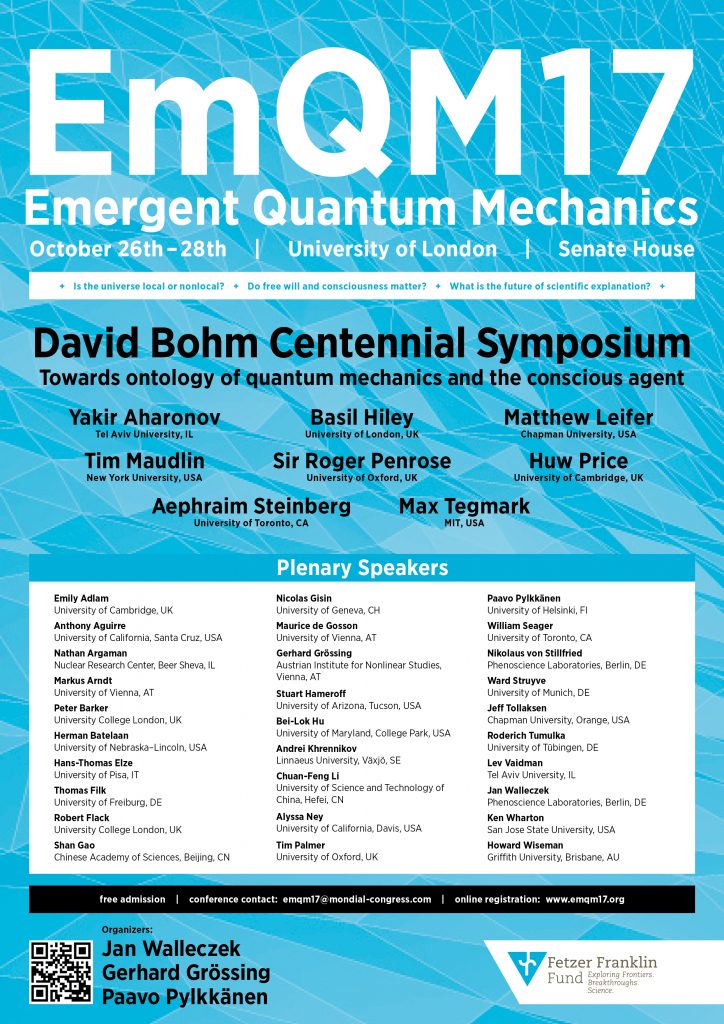Towards Ontology of Quantum Mechanics and the Conscious Agent.
David Bohm Centennial Symposium, in the framework of the 4th International Symposium about Quantum Mechanics based on a »Deeper Level Theory« (Emergent Quantum Mechanics – EmQM17), University of London, 26-28 October, 2017.
Conference webpage.
Objectives
The symposium explored the possibility of an ontology for quantum mechanics. The resurgence of interest in realist approaches to quantum mechanics, including deterministic and indeterministic ones, challenges the standard textbook view. In this effort, the symposium directed focus towards the following questions:
● Are quantum ontologies possible or impossible in view of relativity theory? How to avoid the possibility of causal or information paradoxes? How to interpret the non-signalling theorem?
● Is the universe local or nonlocal? What is the nature of the connection between two distant measurement observations that manifest EPR-type nonlocal correlations?
● Are nonlocal connections – e.g., “action-at-a-distance” – merely a mathematical construct as in the orthodox view, or are they nonlocal causal elements in a radically new conception of reality, e.g., „quantum causality“?
● Does ontological quantum theory call for a new understanding of temporal relations at the quantum level, including temporally indefinite, time-symmetric, or retro-causal effects from the future?
● What new experiments might yield breakthroughs towards answering the question of whether or not ontological approaches to quantum mechanics could ever be validated?
● What is the role of the experimenter agent/scientific observer in realist quantum mechanics? Do free will and consciousness matter? What is the role of agency, e.g., the ability to access and control informational events?
● What is the future of scientific explanation? Is scientific metaphysics, e.g., the notions of causality, reality, and physical influence, obsolete in mathematical or informational accounts of the quantum world?
● Why quantum emergence? What distinguishes weak emergence, e.g., supervenience, from strong emergence? What is the ontological status of epistemically-inaccessible quantum states?
● What is David Bohm’s legacy for the future of quantum physics? What is his contribution to philosophy and to scientific views of reality characterized by monism and a relational ontology?
On the occasion of David Bohm’s 100th birthday, these and related questions were addressed in search of a possible “deeper-level theory” for quantum mechanics that interconnects three fields of knowledge: emergence, the quantum, and information. The symposium offered an open forum for critically evaluating the prospects and significance – for 21st century physics – of ontological quantum mechanics, an approach which David Bohm helped pioneer. Contributions were invited that presented current advances in both standard as well as realist approaches to quantum mechanics, including new experiments, work in quantum foundations, and quantum philosophy.

Organizers
Jan Walleczek (Berlin) | Gerhard Grössing (AINS, Vienna) | Paavo Pylkkänen (Helsinki)
Conference Proceedings
Special Issue of „Entropy“(ISSN 1099-4300). „Emergent Quantum Mechanics – David Bohm Centennial Perspectives“
AINS-publication
In the quest for an understanding of nonlocality with respect to an appropriate ontology, we propose a “cosmological solution”. We assume that from the beginning of the universe each point in space has been the location of a scalar field representing a zero-point vacuum energy that nonlocally vibrates at a vast range of different frequencies across the whole universe. A quantum, then, is a nonequilibrium steady state in the form of a “bouncer” coupled resonantly to one of those (particle type dependent) frequencies, in remote analogy to the bouncing oil drops on an oscillating oil bath as in Couder’s experiments. A major difference to the latter analogy is given by the nonlocal nature of the vacuum oscillations. We show with the examples of double- and n-slit interference that the assumed nonlocality of the distribution functions alone suffices to derive the de Broglie–Bohm guiding equation for N particles with otherwise purely classical means. In our model, no influences from configuration space are required, as everything can be described in 3-space. Importantly, the setting up of an experimental arrangement limits and shapes the forward and osmotic contributions and is described as vacuum landscaping.
Gerhard Grössing, Siegfried Fussy, Johannes Mesa Pascasio and Herbert Schwabl
Vacuum Landscaping: Cause of Nonlocal Influences without Signaling
Entropy 2018, 20(6), 458; https://doi.org/10.3390/e20060458.